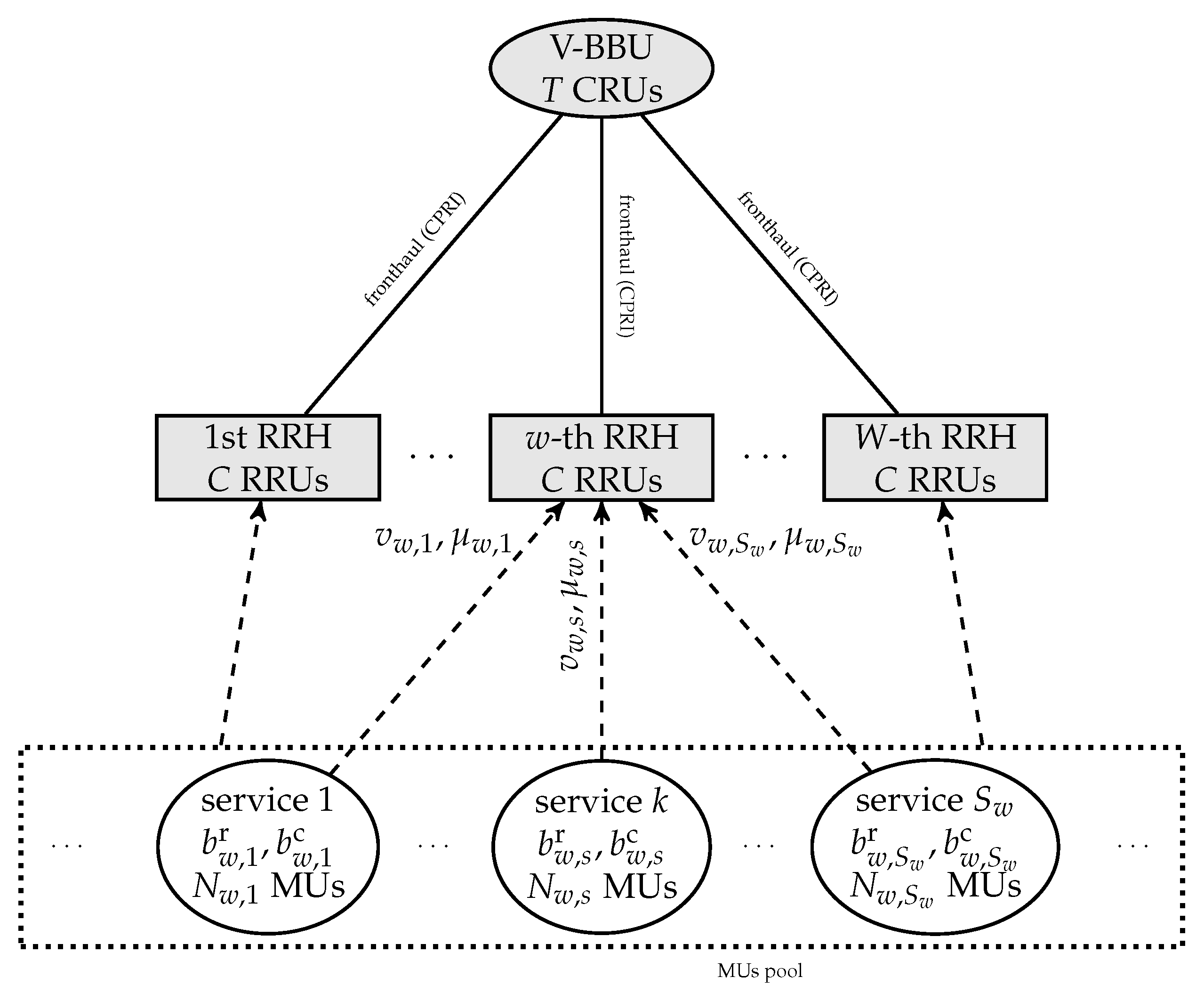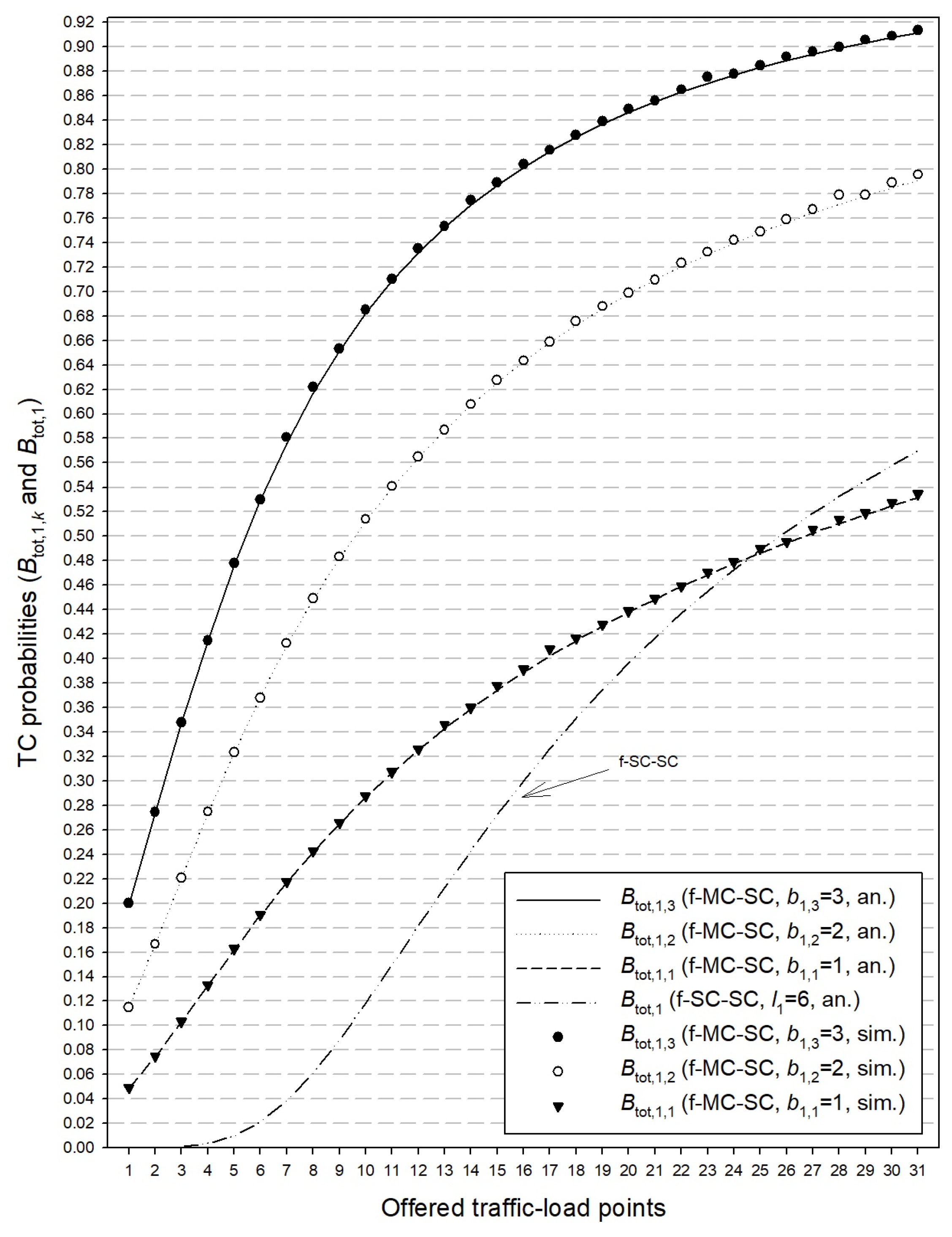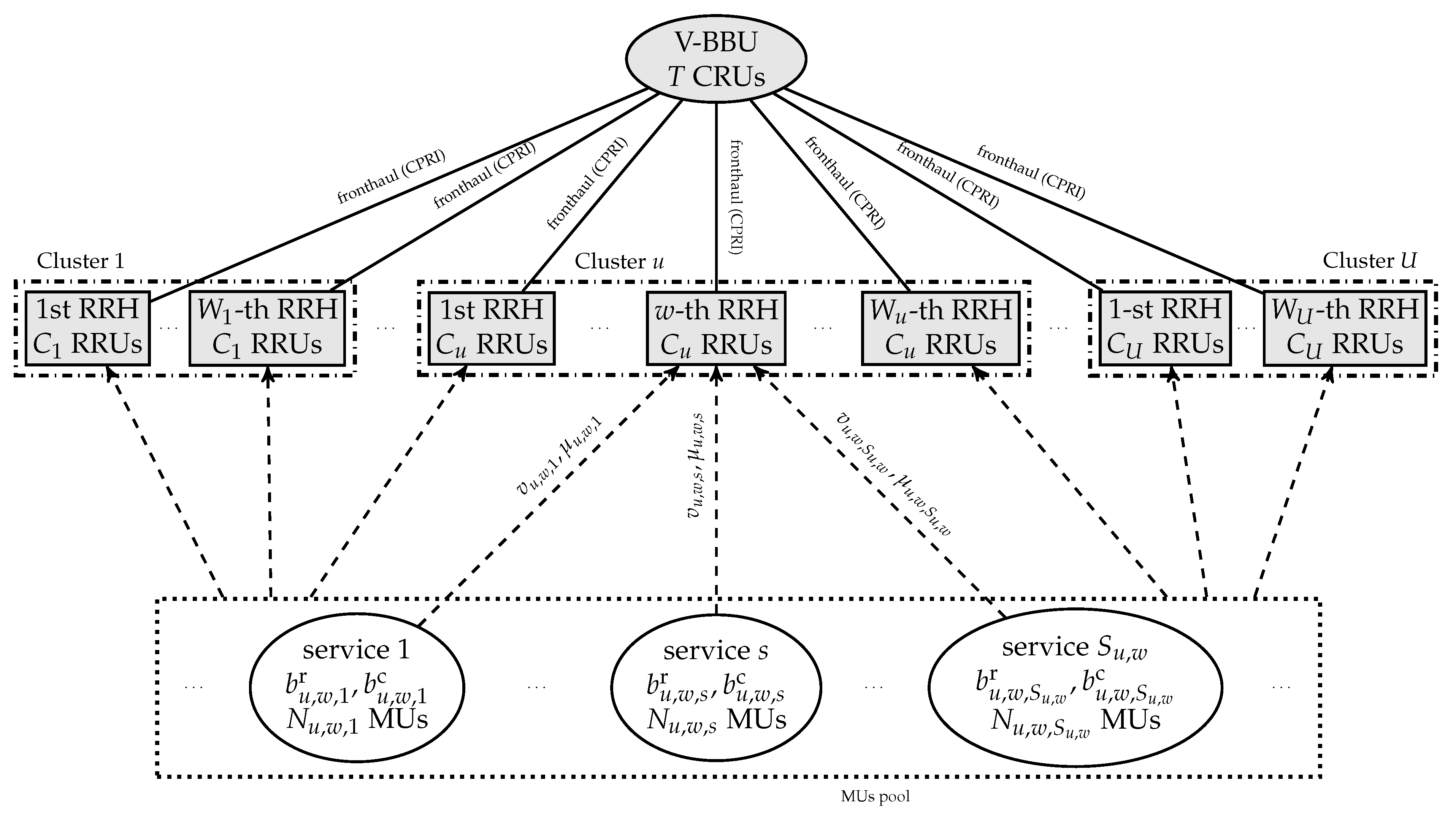Multiservice Loss Models in Single or Multi-Cluster C-RAN Supporting Quasi-Random Traffic
Abstract
:1. Introduction
2. The f-MC-SC Model
2.1. The Analytical Model
2.2. TC Probabilities via the Proposed BF Method
2.3. TC Probabilities via the Proposed Convolution Algorithm
- Step A
- Step B
- Step C
3. Evaluation
4. The Generalized f-MC-MC Model
4.1. The Analytical Model
4.2. The BF Method for the Computation of TC Probabilities
4.3. The Convolution Algorithm for the Computation of TC Probabilities
- Step A
- Step B
- Step C
5. Conclusions
Author Contributions
Funding
Conflicts of Interest
References
- Checko, A.; Christiansen, H.L.; Yan, Y.; Scolari, L.; Kardaras, G.; Berger, M.S.; Dittmann, L. Cloud RAN for Mobile Networks—A Technology Overview. IEEE Commun. Surv. Tutor. 2015, 17, 405–426. [Google Scholar] [CrossRef] [Green Version]
- Zhu, M.; Gu, J.; Zeng, X.; Yan, C.; Gu, P. Delay-Aware Energy-Saving Strategies for BBU Pool in C-RAN: Modeling and Optimization. IEEE Access 2021, 9, 63257–63266. [Google Scholar] [CrossRef]
- Alimi, I.; Teixeira, A.; Monteiro, P. Toward an Efficient C-RAN Optical Fronthaul for the Future Networks: A Tutorial on Technologies, Requirements, Challenges, and Solutions. IEEE Commun. Surv. Tutor. 2018, 20, 708–769. [Google Scholar] [CrossRef]
- Aqeeli, E.; Moubayed, A.; Shami, A. Power-Aware Optimized RRH to BBU Allocation in C-RAN. IEEE Trans. Wirel. Commun. 2018, 17, 1311–1322. [Google Scholar] [CrossRef]
- Pliatsios, D.; Sarigiannidis, P.; Goudos, S.; Karagiannidis, G. Realizing 5G vision through Cloud RAN: Technologies, challenges, and trends. EURASIP J. Wirel. Commun. Netw. 2018, 2018, 136. [Google Scholar] [CrossRef] [Green Version]
- Rodoshi, R.T.; Kim, T.; Choi, W. Resource Management in Cloud Radio Access Network: Conventional and New Approaches. Sensors 2020, 20, 2708. [Google Scholar] [CrossRef]
- Mohammedali, N.A.; Kanakis, T.; Agyeman, M.O.; Al-Sherbaz, A. A Survey of Mobility Management as a Service in Real-Time Inter/Intra Slice Control. IEEE Access 2021, 9, 62533–62552. [Google Scholar] [CrossRef]
- Mukhlif, F.; Noordin, K.; Mansoor, A.; Kasirun, Z. Green transmission for C-RAN based on SWIPT in 5G: A review. Wirel. Netw. 2019, 25, 2621–2649. [Google Scholar] [CrossRef]
- Wang, L.; Zhou, S. On the Fronthaul Statistical Multiplexing Gain. IEEE Commun. Lett. 2017, 21, 1099–1102. [Google Scholar] [CrossRef]
- Larsen, L.; Checko, A.; Christiansen, H. A Survey of the Functional Splits Proposed for 5G Mobile Crosshaul Networks. IEEE Commun. Surv. Tutor. 2019, 21, 146–172. [Google Scholar] [CrossRef] [Green Version]
- Ismail, T.; Mahmoud, H.H.M. Optimum Functional Splits for Optimizing Energy Consumption in V-RAN. IEEE Access 2020, 8, 194333–194341. [Google Scholar] [CrossRef]
- Ahmad, I.; Kumar, T.; Liyanage, M.; Okwuibe, J.; Ylianttila, M.; Gurtov, A. Overview of 5G Security Challenges and Solutions. IEEE Commun. Stand. Mag. 2018, 2, 36–43. [Google Scholar] [CrossRef] [Green Version]
- Santoyo-González, A.; Cervelló-Pastor, C. Network-Aware Placement Optimization for Edge Computing Infrastructure Under 5G. IEEE Access 2020, 8, 56015–56028. [Google Scholar] [CrossRef]
- Dai, B.; Yu, W. Energy Efficiency of Downlink Transmission Strategies for Cloud Radio Access Networks. IEEE J. Sel. Areas Commun. 2016, 34, 1037–1050. [Google Scholar] [CrossRef] [Green Version]
- Li, Y.; Jiang, T.; Luo, K.; Mao, S. Green Heterogeneous Cloud Radio Access Networks: Potential Techniques, Performance Trade-offs, and Challenges. IEEE Commun. Mag. 2017, 55, 33–39. [Google Scholar] [CrossRef]
- Tian, B.; Zhang, Q.; Li, Y.; Tornatore, M. Joint Optimization of Survivability and Energy Efficiency in 5G C-RAN With mm-Wave Based RRH. IEEE Access 2020, 8, 100159–100171. [Google Scholar] [CrossRef]
- Masoudi, M.; Lisi, S.S.; Cavdar, C. Cost-Effective Migration Toward Virtualized C-RAN With Scalable Fronthaul Design. IEEE Syst. J. 2020, 14, 5100–5110. [Google Scholar] [CrossRef]
- Ferrus, R.; Sallent, O.; Perez-Romero, J.; Agusti, R. On 5G Radio Access Network Slicing: Radio Interface Protocol Features and Configuration. IEEE Commun. Mag. 2018, 56, 184–192. [Google Scholar] [CrossRef]
- AlQahtani, S.; Alhomiqani, W. A multi-stage analysis of network slicing architecture for 5G mobile networks. Telecommun. Syst. 2020, 73, 205–221. [Google Scholar] [CrossRef]
- Shen, X.; Gao, J.; Wu, W.; Lyu, K.; Li, M.; Zhuang, W.; Li, X.; Rao, J. AI-Assisted Network-Slicing Based Next-Generation Wireless Networks. IEEE Open J. Veh. Technol. 2020, 1, 45–66. [Google Scholar] [CrossRef]
- Liu, J.; Zhou, S.; Gong, J.; Niu, Z.; Xu, S. On the statistical multiplexing gain of virtual base station pools. In Proceedings of the 2014 IEEE Global Communications Conference, Austin, TX, USA, 8–12 December 2014; pp. 2283–2288. [Google Scholar] [CrossRef] [Green Version]
- Avramova, A.; Christiansen, H.; Iversen, V. Cell Deployment Optimization for Cloud Radio Access Networks using Teletraffic Theory. In Proceedings of the Fifth International Conference on Advanced Communications and Computation, Brussels, Belgium, 21–26 June 2015; pp. 96–101. [Google Scholar]
- Checko, A.; Avramova, A.; Berger, M.; Christiansen, H. Evaluating C-RAN fronthaul functional splits in terms of network level energy and cost savings. J. Commun. Netw. 2016, 18, 162–172. [Google Scholar] [CrossRef] [Green Version]
- Liu, J.; Zhou, S.; Gong, J.; Niu, Z.; Xu, S. Statistical Multiplexing Gain Analysis of Heterogeneous Virtual Base Station Pools in Cloud Radio Access Networks. IEEE Trans. Wirel. Commun. 2016, 15, 5681–5694. [Google Scholar] [CrossRef] [Green Version]
- Chousainov, I.A.; Moscholios, I.; Sarigiannidis, P.; Kaloxylos, A.; Logothetis, M. An analytical framework of a C-RAN supporting random, quasi-random and bursty traffic. Comput. Netw. 2020, 180, 107410. [Google Scholar] [CrossRef]
- Chousainov, I.A.; Moscholios, I.D.; Sarigiannidis, P.G. Congestion Probabilities in a Multi-Cluster C-RAN Servicing a Mixture of Traffic Sources. Electronics 2020, 9, 2120. [Google Scholar] [CrossRef]
- Chousainov, I.A.; Moscholios, I.; Kaloxylos, A.; Logothetis, M. Performance Evaluation of a C-RAN Supporting Quasi-Random Traffic. In Proceedings of the 2019 International Conference on Software, Telecommunications and Computer Networks (SoftCOM), Split, Croatia, 19–21 September 2019; pp. 1–6. [Google Scholar] [CrossRef]
- Chousainov, I.A.; Moscholios, I.; Kaloxylos, A.; Logothetis, M. Performance Evaluation in Single or Multi-Cluster C-RAN Supporting Quasi-Random Traffic. J. Commun. Softw. Syst. 2020, 16, 170–179. [Google Scholar] [CrossRef]
- Stasiak, M.; Głąbowski, M.; Wisniewski, A.; Zwierzykowski, P. Modeling and Dimensioning of Mobile Networks: From GSM to LTE; John Wiley: Hoboken, NJ, USA, 2011. [Google Scholar] [CrossRef]
- Moscholios, I.; Logothetis, M. Efficient Multirate Teletraffic Loss Models beyond Erlang; JohnWiley & IEEE Press: Hoboken, NJ, USA, 2019. [Google Scholar] [CrossRef]
- Moscholios, I.; Logothetis, M.; Boucouvalas, A. Blocking probabilities of elastic and adaptive calls in the Erlang multirate loss model under the threshold policy. Telecommun. Syst. 2016, 62, 245–262. [Google Scholar] [CrossRef]
- Głąbowski, M.; Kaliszan, A.; Stasiak, M. Modelling overflow systems with distributed secondary resources. Comput. Netw. 2016, 108, 171–183. [Google Scholar] [CrossRef]
- Moscholios, I.; Vassilakis, V.; Logothetis, M.; Boucouvalas, A. State-dependent bandwidth sharing policies for wireless multirate loss networks. IEEE Trans. Wirel. Commun. 2017, 16, 5481–5497. [Google Scholar] [CrossRef] [Green Version]
- Vassilakis, V.; Moscholios, I.; Logothetis, M. Efficient radio resource allocation in SDN/NFV based mobile cellular networks under the complete sharing policy. IET Netw. 2018, 7, 103–108. [Google Scholar] [CrossRef] [Green Version]
- Hanczewski, S.; Stasiak, M.; Weissenberg, J. Queueing model of a multi-service system with elastic and adaptive traffic. Comput. Netw. 2018, 147, 146–161. [Google Scholar] [CrossRef]
- Moscholios, I.; Vassilakis, V.; Sagias, N.; Logothetis, M. On Channel Sharing Policies in LEO Mobile Satellite Systems. IEEE Trans. Aerosp. Electron. Syst. 2018, 54, 1628–1640. [Google Scholar] [CrossRef] [Green Version]
- Panagoulias, P.; Moscholios, I. Congestion probabilities in the X2 link of LTE Networks. Telecommun. Syst. 2019, 17, 585–599. [Google Scholar] [CrossRef]
- Głąbowski, M.; Kaliszan, A.; Stasiak, M. A Palm-Jacobaeus Loss Formula for Multi-Service Systems with Separated Resources. Appl. Sci. 2020, 10, 4019. [Google Scholar] [CrossRef]
- Głąbowski, M.; Sobieraj, M.; Stasiak, M.; Dominik Stasiak, M. Modeling of Clos Switching Structures with Dynamically Variable Number of Active Switches in the Spine Stage. Electronics 2020, 9, 1073. [Google Scholar] [CrossRef]
- Panagoulias, P.; Moscholios, I.; Sarigiannidis, P.; Logothetis, M. Congestion probabilities in OFDM wireless networks with compound Poisson arrivals. IET Commun. 2020, 14, 674–681. [Google Scholar] [CrossRef]
- Głąbowski, M.; Leitgeb, E.; Sobieraj, M.; Stasiak, M. Analytical Modeling of Switching Fabrics of Elastic Optical Networks. IEEE Access 2020, 8, 193462–193477. [Google Scholar] [CrossRef]
- Głąbowski, M.; Kmiecik, D.; Stasiak, M. On Increasing the Accuracy of Modeling Multi-Service Overflow Systems with Erlang-Engset-Pascal Streams. Electronics 2021, 10, 508. [Google Scholar] [CrossRef]
- Yan, F.; Maillé, P.; Lagrange, X. Performance analysis of cellular networks with delay tolerant users. Telecommun. Syst. 2021, 77, 241–253. [Google Scholar] [CrossRef]
- Wang, X.; Gao, L. When 5G Meets Industry 4.0; Springer Nature: Singapore, 2020. [Google Scholar] [CrossRef]
- Kim, D.; Kim, S. Network slicing as enablers for 5G services: State of the art and challenges for mobile industry. Telecommun. Syst. 2019, 71, 517–527. [Google Scholar] [CrossRef]
- Chousainov, I.A.; Moscholios, I.; Sarigiannidis, P.; Logothetis, M. Multiservice Loss Models for Cloud Radio Access Networks. IEEE Access 2021. [Google Scholar] [CrossRef]
- Głąbowski, M.; Kaliszan, A.; Stasiak, M. On the Application of the Asymmetric Convolution Algorithm in Modeling of Full-Availability Group with Bandwidth Reservation. In International Teletraffic Congress; Springer: Berlin/Heidelberg, Germany, 2007; Volume 4516, pp. 878–889. [Google Scholar] [CrossRef]
- Głąbowski, M.; Kaliszan, A.; Stasiak, M. Convolution Algorithm for State-Passage Probabilities Calculation in Limited-Availability Group. In Proceedings of the Fourth Advanced International Conference on Telecommunications, Athens, Greece, 8–13 June 2008; pp. 215–220. [Google Scholar] [CrossRef]
- Huang, Q.; Ko, K.T.; Iversen, V.B. A new convolution algorithm for loss probability analysis in multiservice networks. Perform. Eval. 2011, 68, 76–87. [Google Scholar] [CrossRef]
- Hanczewski, S.; Kaliszan, A.; Stasiak, M. Convolution model of a queueing system with the cFIFO service discipline. Mob. Inf. Syst. 2016, 2016, 2185714. [Google Scholar] [CrossRef]
- Moscholios, I.; Vassilakis, V.; Logothetis, M.; Boucouvalas, A. A Probabilistic Threshold-Based Bandwidth Sharing Policy for Wireless Multirate Loss Networks. IEEE Wirel. Commun. Lett. 2016, 5, 304–307. [Google Scholar] [CrossRef] [Green Version]
- Sagkriotis, S.; Pantelis, S.; Moscholios, I.; Vassilakis, V. Call blocking probabilities in a two-link multirate loss system for Poisson traffic. IET Netw. 2018, 7, 233–241. [Google Scholar] [CrossRef]
- Sopin, E.; Ageev, K.; Markova, E.; Vikhrova, O.; Gaidamaka, Y. Performance Analysis of M2M Traffic in LTE Network Using Queuing Systems with Random Resource Requirements. Autom. Control. Comput. Sci. 2018, 52, 345–353. [Google Scholar] [CrossRef]
- Efrosinin, D.; Stepanova, N. Estimation of the Optimal Threshold Policy in a Queue with Heterogeneous Servers Using a Heuristic Solution and Artificial Neural Networks. Mathematics 2021, 9, 1267. [Google Scholar] [CrossRef]
- Rice, S.; Marjanski, A.; Markowitz, H.; Bailey, S. The SIMSCRIPT III programming language for modular object-oriented simulation. In Proceedings of the Winter Simulation Conference, Orlando, FL, USA, 4 December 2005. [Google Scholar] [CrossRef]
- Jain, R. The Art of Computer Systems Performance Analysis; John Wiley & Sons: Hoboken, NJ, USA, 1991. [Google Scholar]
- Robinson, S. A statistical process control approach to selecting a warm-up period for a discrete-event simulation. Eur. J. Oper. Res. 2007, 176, 332–346. [Google Scholar] [CrossRef]
- Johnson, S.A. A performance analysis of integrated communications systems. Br. Telecom Technol. J. 1985, 3, 36–45. [Google Scholar]
- Moscholios, I.; Vardakas, J.; Logothetis, M.; Boucouvalas, A. New Algorithms for Performance Measures Derivatives in the Erlang Multirate Loss Model including the Bandwidth Reservation Policy. Mediterr. J. Comput. Netw. 2011, 7, 304–316. [Google Scholar]
- Moscholios, I.D.; Logothetis, M.D.; Kokkinakis, G.K. Connection-Dependent Threshold Model: A Generalization of the Erlang Multiple Rate Loss Model. Perform. Eval. 2002, 48, 177–200. [Google Scholar] [CrossRef]
- Moscholios, I.D.; Logothetis, M.D.; Nikolaropoulos, P.I. Engset Multi-Rate State-Dependent Loss Models. Perform. Eval. 2005, 59, 247–277. [Google Scholar] [CrossRef]
- Glabowski, M.; Sobieraj, M.; Stasiak, M. A full-availability group model with multi-service sources and threshold mechanisms. In Proceedings of the 8th International Symposium on Communication Systems, Networks Digital Signal Processing (CSNDSP), Poznan, Poland, 18–20 July 2012; pp. 1–5. [Google Scholar] [CrossRef]
- Moscholios, I.; Vardakas, J.; Boucouvalas, A. Congestion Probabilities in a Batched Poisson Multirate Loss Model Supporting Elastic and Adaptive Traffic. Ann. Telecommun. 2012, 68, 327–344. [Google Scholar] [CrossRef]
- Hanczewski, S.; Stasiak, M.; Weissenberg, J. A Model of a System With Stream and Elastic Traffic. IEEE Access 2021, 9, 7789–7796. [Google Scholar] [CrossRef]
- Vazquez-Avila, J.; Cruz-Perez, F.; Ortigoza-Guerrero, L. Performance analysis of fractional guard channel policies in mobile cellular networks. IEEE Trans. Wirel. Commun. 2006, 5, 301–305. [Google Scholar] [CrossRef]
- Bouraqia, K.; Sabir, E.; Sadik, M.; Ladid, L. Quality of Experience for Streaming Services: Measurements, Challenges and Insights. IEEE Access 2020, 8, 13341–13361. [Google Scholar] [CrossRef]
- Barakabitze, A.A.; Barman, N.; Ahmad, A.; Zadtootaghaj, S.; Sun, L.; Martini, M.G.; Atzori, L. QoE Management of Multimedia Streaming Services in Future Networks: A Tutorial and Survey. IEEE Commun. Surv. Tutor. 2020, 22, 526–565. [Google Scholar] [CrossRef] [Green Version]











| BBU | Baseband units |
| BF | Brute force |
| CAC | Call admission control |
| CBP | Call blocking probabilities |
| CC | Call congestion |
| CPRI | Common public radio interface |
| C-RAN | Cloud radio access network |
| CRUs | Computational resource units |
| f-MC-MC | Finite multi-class-multi-cluster |
| f-MC-SC | Finite multi-class-single-cluster |
| f-SC-MC | Finite single-class-multi-cluster |
| f-SC-SC | Finite single-class-single-cluster |
| MUs | Mobile users |
| NFV | Network function virtualization |
| PFS | Product form solution |
| o.d. | Occupancy distribution |
| QoE | Quality of experience |
| QoS | Quality of service |
| RRH | Remote radio head |
| RRUs | Radio resource units |
| RUs | Resource units |
| TC | Time congestion |
| V-BBU | Virtualized BBU |
Publisher’s Note: MDPI stays neutral with regard to jurisdictional claims in published maps and institutional affiliations. |
© 2021 by the authors. Licensee MDPI, Basel, Switzerland. This article is an open access article distributed under the terms and conditions of the Creative Commons Attribution (CC BY) license (https://creativecommons.org/licenses/by/4.0/).
Share and Cite
Chousainov, I.-A.; Moscholios, I.; Sarigiannidis, P.; Logothetis, M. Multiservice Loss Models in Single or Multi-Cluster C-RAN Supporting Quasi-Random Traffic. Appl. Sci. 2021, 11, 8559. https://doi.org/10.3390/app11188559
Chousainov I-A, Moscholios I, Sarigiannidis P, Logothetis M. Multiservice Loss Models in Single or Multi-Cluster C-RAN Supporting Quasi-Random Traffic. Applied Sciences. 2021; 11(18):8559. https://doi.org/10.3390/app11188559
Chicago/Turabian StyleChousainov, Iskanter-Alexandros, Ioannis Moscholios, Panagiotis Sarigiannidis, and Michael Logothetis. 2021. "Multiservice Loss Models in Single or Multi-Cluster C-RAN Supporting Quasi-Random Traffic" Applied Sciences 11, no. 18: 8559. https://doi.org/10.3390/app11188559








